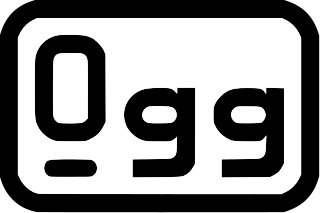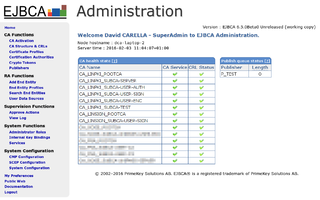A compiler is a computer program that translates computer code written in one programming language into another programming language. The name compiler is primarily used for programs that translate source code from a high-level programming language to a lower level language to create an executable program.
In computer science, the Earley parser is an algorithm for parsing strings that belong to a given context-free language, though it may suffer problems with certain nullable grammars. The algorithm, named after its inventor, Jay Earley, is a chart parser that uses dynamic programming; it is mainly used for parsing in computational linguistics. It was first introduced in his dissertation in 1968.

Ogg is a free, open container format maintained by the Xiph.Org Foundation. The creators of the Ogg format state that it is unrestricted by software patents and is designed to provide for efficient streaming and manipulation of high-quality digital multimedia. Its name is derived from "ogging", jargon from the computer game Netrek.
In computing, the Java API for XML Processing, or JAXP, one of the Java XML Application programming interfaces (API)s, provides the capability of validating and parsing XML documents. It has three basic parsing interfaces:
In computer science, an interpreter is a computer program that directly executes instructions written in a programming or scripting language, without requiring them previously to have been compiled into a machine language program. An interpreter generally uses one of the following strategies for program execution:
- Parse the source code and perform its behavior directly;
- Translate source code into some efficient intermediate representation and immediately execute this;
- Explicitly execute stored precompiled code made by a compiler which is part of the interpreter system.
In computer science, a recursive descent parser is a kind of top-down parser built from a set of mutually recursive procedures where each such procedure implements one of the nonterminals of the grammar. Thus the structure of the resulting program closely mirrors that of the grammar it recognizes.
Abstract Syntax Notation One (ASN.1) is a standard interface description language for defining data structures that can be serialized and deserialized in a cross-platform way. It is broadly used in telecommunications and computer networking, and especially in cryptography.

Apache Tomcat implements several Java EE specifications including Java Servlet, JavaServer Pages (JSP), Java EL, and WebSocket, and provides a "pure Java" HTTP web server environment in which Java code can run.
External Data Representation (XDR) is a standard data serialization format, for uses such as computer network protocols. It allows data to be transferred between different kinds of computer systems. Converting from the local representation to XDR is called encoding. Converting from XDR to the local representation is called decoding. XDR is implemented as a software library of functions which is portable between different operating systems and is also independent of the transport layer.
In computer science, data that has several parts, known as a record, can be divided into fields. Relational databases arrange data as sets of database records, also called rows. Each record consists of several fields; the fields of all records form the columns. Examples of fields: name, gender, hair colour.
In computing, a comma-separated values (CSV) file is a delimited text file that uses a comma to separate values. A CSV file stores tabular data in plain text. Each line of the file is a data record. Each record consists of one or more fields, separated by commas. The use of the comma as a field separator is the source of the name for this file format.
In computing, memoization or memoisation is an optimization technique used primarily to speed up computer programs by storing the results of expensive function calls and returning the cached result when the same inputs occur again. Memoization has also been used in other contexts, such as in simple mutually recursive descent parsing. Although related to caching, memoization refers to a specific case of this optimization, distinguishing it from forms of caching such as buffering or page replacement. In the context of some logic programming languages, memoization is also known as tabling.
Various governments require a certification of voting machines.

The shapefile format is a popular geospatial vector data format for geographic information system (GIS) software. It is developed and regulated by Esri as a (mostly) open specification for data interoperability among Esri and other GIS software products. The shapefile format can spatially describe vector features: points, lines, and polygons, representing, for example, water wells, rivers, and lakes. Each item usually has attributes that describe it, such as name or temperature.
Within data communication protocols, TLV is an encoding scheme used for optional information element in a certain protocol.

EJBCA, is a free software public key infrastructure (PKI) certificate authority software package maintained and sponsored by the Swedish for-profit company PrimeKey Solutions AB, which holds the copyright to most of the codebase. The project's source code is available under terms of the Lesser GNU General Public License.

Structured prediction or structured (output) learning is an umbrella term for supervised machine learning techniques that involves predicting structured objects, rather than scalar discrete or real values.
Data Format Description Language, published as an Open Grid Forum Proposed Recommendation in January 2011, is a modeling language for describing general text and binary data in a standard way. A DFDL model or schema allows any text or binary data to be read from its native format and to be presented as an instance of an information set.. The same DFDL schema also allows data to be taken from an instance of an information set and written out to its native format.
P4 is a programming language designed to allow programming of packet forwarding planes. In contrast to a general purpose language such as C or Python, P4 is a domain-specific language with a number of constructs optimized around network data forwarding. P4 is an open-source, permissively licensed language and is maintained by a non-profit organization called the P4 Language Consortium. The language was originally described in a SIGCOMM CCR paper in 2014 titled “Programming Protocol-Independent Packet Processors” – the alliterative name shortens to “P4”.




